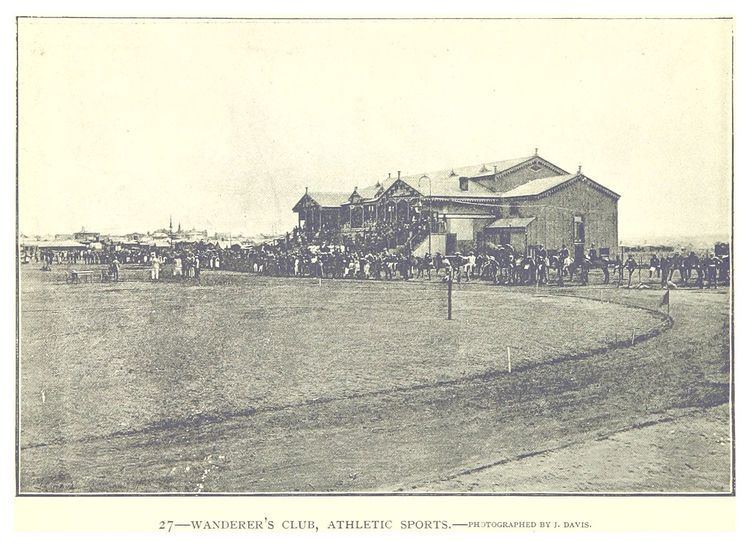Capacity n/a | Establishment 1888 | |
 | ||
Tenants South Africa national cricket team, Gauteng cricket team | ||
Sibylle baier give me a smile
Old Wanderers was a cricket ground in Johannesburg, South Africa. The ground hosted 22 Test matches from 1895 to 1939, before being rebuilt as Johannesburg's Park Station in 1946. It has since been replaced by the New Wanderers Stadium.
Contents
- Sibylle baier give me a smile
- Crus fc vs old wanderers
- History
- Cricket history
- International Centuries
- References
Crus fc vs old wanderers
History
The wealthy elite of the town saw a need for a sports ground for the public in the new town of Johannesburg. Around 1888 a deputation consisting of Hermann Eckstein, J.B. Taylor, Jacob Swart, Llewellyn Andersson and others rode to Pretoria to meet with President Paul Kruger. He was shown a piece of land of 40 acres west of Joubert Park, but as the land was to be surveyed and sold as leasehold stands, he was concerned about the loss of income to the South African Republic. A compromise was reached and 31 acres was set aside for a sporting ground with a 99-year lease and 25 pounds a year. The ground was first called Kruger's Park but was later renamed Wanderers Club, with Hermann Eckstein and its first chairman and J.B. Taylor as its vice-chairman. When not used by the club, the grounds would be used as a public venue. It was the venue for the Witwatersrand's first horse show, gymkhana and dog show in May 1891 and with a cycle track around the cricket ground people saw future world cycle champion Laurens Meintjes race. And in November 1894, the Witwatersrand Agricultural Society would hold its first show at the Wanderers ground before moving it to Braamfontein where it would be later known as the Rand Show. The grounds would host its first cricket test match on 2 March 1896 when South Africa played England.
By the late 1920s, the station passenger numbers south of the Wanderers grounds had outgrown its facilities. The new station would need additional land which was only available to the north and which was part of the Old Wanderers ground. There was opposition to the idea by the people of Johannesburg when a 100 ft strip of the Wanderers ground was proposed with the South African Railways offering ₤31,000 and the club wanting the amount doubled. The land was lost to the railways with the final amount settled on was ₤35,000
In 1936, the club purchased 200 acres in Illovo and established a golf course called Kent Park, name after its chairman Victor Kent. This would later become the venue for the new Wanderers Stadium cricket ground.
By 1945, the Johannesburg Park Station had reached a capacity of 130,000 passengers a day and there was a need to expand the station's infrastructure with a new station, administrative buildings and a newer bridge over the railway lines and so the ideal land for the project was the Wanderers ground. Transport Minister F.C. Sturrock would attempt to sell the project to the public while it was countered by the Wanderers Club and Johannesburg Publicity Association, representing about fifty other bodies.
The South African government would expropriate the Wanderers ground and after a legal appeal by those who disagreed, on 30 March 1946, the Appellate Division of the Supreme Court upheld the governments decision. The Government would pay the Wanderers Club ₤500,000 in compensation and the Johannesburg Council ₤1,000,000 in the form of land at Plein Square, Kazerne and a small amount of land in Braamfontein and offset ₤300,000 owed by the council.
Cricket history
The highest Test innings recorded at the ground was South Africa's 491 in their 2nd innings in the drawn 2nd Test against Australia in 1935/36,[1] and the lowest was South Africa's 85 in their 2nd innings in the 2nd Test in 1902/03, on the way to losing to Australia by 159 runs (Jack Saunders taking 7/34). [2] The ground saw 29 Test centuries, including double centuries for South African Dudley Nourse (231) in the drawn 2nd Test against Australia in 1934/35 [3] and Australian captain and opening batsman Herbie Collins (203) in the drawn 2nd Test in 1921/22 (only his 10th Test match, and his 2nd as captain). [4]
George Lohmann's 9/28 at Old Wanderers in the 2nd Test in 1896 was for six decades the best bowling figures in Test cricket, leading to a victory for England by an innings and 197 runs. [5] The best bowling analysis for a Test match at the ground was Sydney Barnes's 17/159 for England in the 2nd Test in 1913/14 (8/56 and 9/103) in a victory by England by an innings and 12 runs.[6]. The only other bowler to take 8 wickets in an innings at Old Wanderers was Tip Snooke in the 3rd Test against England (and only his third Test match) in 1905/06. [7]
International Centuries
From 1895 to 1939, twenty nine Test centuries have been scored.
